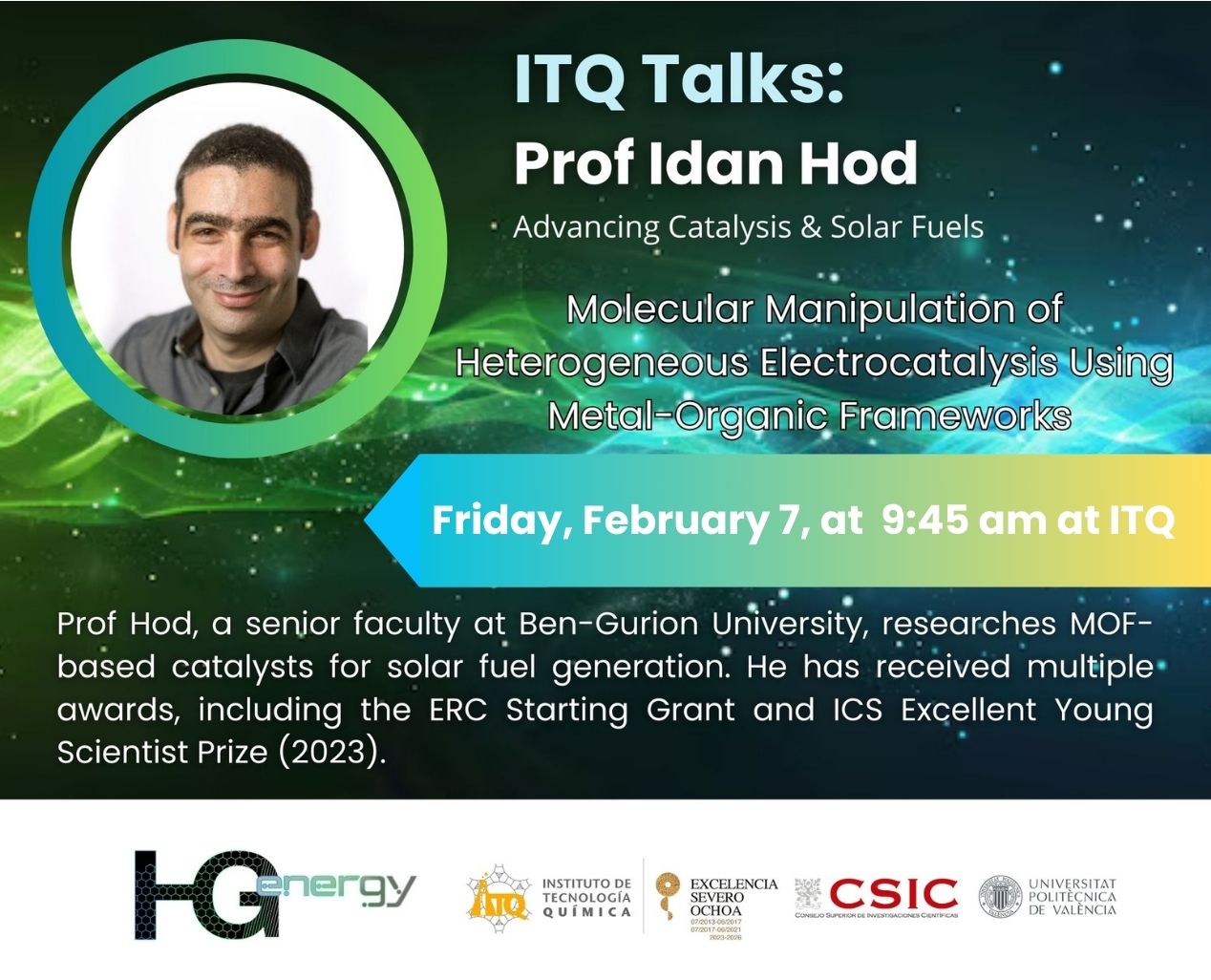“ITQ Talks: Prof. Idan Hod on MOFs & Electrocatalysis for Solar Fuels” Friday, February 7, at 9:45 am at ITQ
HG-energy from the Instituto de Tecnología Química (ITQ) will welcome Prof. Idan Hod from Ben-Gurion University for a talk on “Molecular Manipulation of Heterogeneous Electrocatalysis Using Metal-Organic Frameworks.” The talk will take place on Friday, February 7, at 9:45 AM in the ITQ Assembly Hall.
Prof. Hod specializes in MOF-based catalysts for solar fuel generation and has received prestigious awards, including the ERC Starting Grant and the ICS Excellent Young Scientist Prize (2023). His research focuses on advancing electrocatalytic energy conversion through innovative material design.
Don’t miss this opportunity to explore cutting-edge developments in sustainable energy!
Biography
Idan Hod was born in 1981 in Petach-Tikva, Israel. He received all his degrees from Bar-Ilan University, including B.Sc. in chemistry and computer science, M.Sc. on molecular crystal engineering with Prof. Yitzhak Mastai, and Ph.D. on photo-electrochemistry of quantum dot sensitized solar cells with Prof. Arie Zaban. After a 3-year postdoctoral spell with Prof. Joseph T. Hupp at Northwestern University (Department of Chemistry), IL, USA, he was appointed as a senior faculty member at the Chemistry Department in Ben-Gurion University of the Negev, Israel. His main research interests focus on the development of new concepts for molecular level manipulation of heterogenous catalysts using functional, porous materials and their implementation in (photo)-electrochemical solar fuel generation. A key aspect of his research focuses on studying the exceptional capability of MOFs to precisely tune and manipulate the properties of the catalytically-active site and its surrounding chemical environment, in order to utilize MOF-based systems as a high surface area platform for driving electrocatalytic energy-conversion reactions. Idan’s list of awards includes the American Chemical Society (ACS) physical chemistry division postdoctoral award (2015), Alon fellowship for new faculty members (2018), Israel Vacuum Society (IVS) early career research excellence award (2020), Krill prize for excellence in scientific research (2020), Toronto prize for excellence in research (2023), ICS Excellent Young Scientist Prize (2023), and an ERC starting grant.
Abstract
Molecular Manipulation of Heterogeneous Electrocatalysis Using Metal-Organic Frameworks
- Shimoni,1 A. Ghatak, 1 S. Shankar Golla, 1 S. Mukhopadhyay,1 I. Liberman,1 I. Hod*1
1 Department of Chemistry at Ben-Gurion University of the Negev (BGU), Beer-Sheva, Israel
Electrocatalytically driven reactions that produce alternative fuels and chemicals are considered as a useful means to store renewable energy in the form of chemical bonds. in recent years there has been a significant increase in research efforts aiming to develop highly efficient electrocatalysts that are able to drive those reactions. Yet, despite having made significant progress in this field, there is still a need for developing new materials that could function both as active and selective electrocatalysts.
In that respect, Metal–Organic Frameworks (MOFs), are an emerging class of hybrid materials with immense potential in electrochemical catalysis. Yet, to reach a further leap in our understanding of electrocatalytic MOF-based systems, one also needs to consider the well-defined structure and chemical modularity of MOFs as another important virtue for efficient electrocatalysis, as it can be used to fine-tune the immediate chemical environment of the active site, and thus affect its overall catalytic performance. Our group utilizes Metal-Organic Frameworks (MOFs) based materials as a platform for imposing molecular approaches to control and manipulate heterogenous electrocatalytic systems. In this talk, I will present our recent study on electrocatalytic schemes involving MOFs, acting as: a) electroactive unit that incorporates molecular electrocatalysts, or b) non-electroactive MOF-based membranes coated on solid heterogenous catalysts.





